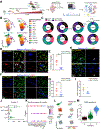TREM2 drives microglia response to amyloid-β via SYK-dependent and -independent pathways
- PMID: 36306735
- PMCID: PMC9625082
- DOI: 10.1016/j.cell.2022.09.033
TREM2 drives microglia response to amyloid-β via SYK-dependent and -independent pathways
Abstract
Genetic studies have highlighted microglia as pivotal in orchestrating Alzheimer's disease (AD). Microglia that adhere to Aβ plaques acquire a transcriptional signature, "disease-associated microglia" (DAM), which largely emanates from the TREM2-DAP12 receptor complex that transmits intracellular signals through the protein tyrosine kinase SYK. The human TREM2R47H variant associated with high AD risk fails to activate microglia via SYK. We found that SYK-deficient microglia cannot encase Aβ plaques, accelerating brain pathology and behavioral deficits. SYK deficiency impaired the PI3K-AKT-GSK-3β-mTOR pathway, incapacitating anabolic support required for attaining the DAM profile. However, SYK-deficient microglia proliferated and advanced to an Apoe-expressing prodromal stage of DAM; this pathway relied on the adapter DAP10, which also binds TREM2. Thus, microglial responses to Aβ involve non-redundant SYK- and DAP10-pathways. Systemic administration of an antibody against CLEC7A, a receptor that directly activates SYK, rescued microglia activation in mice expressing the TREM2R47H allele, unveiling new options for AD immunotherapy.
Keywords: Alzheimer's disease; ApoE; Dectin1; GSK-3β; Syk; TREM2; immunotherapy; metabolism; microglia; signaling.
Copyright © 2022 Elsevier Inc. All rights reserved.
Conflict of interest statement
Declaration of interests M. Colonna is a member of Vigil Neuro scientific advisory board (SAB), is consultant for Cell Signaling Technology and NGM Bio, has received research grants from Vigil Neuro during the conduct of the study, and has a patent to TREM2 pending. DMH co-founded and is on the SAB of C2N Diagnostics; is on the SAB of Denali, Genentech, and Cajal Neuroscience; consults for Alector; and is on the Advisory Board for Cell.
Figures







Comment in
-
Microglia are SYK of Aβ and cell debris.Cell. 2022 Oct 27;185(22):4043-4045. doi: 10.1016/j.cell.2022.09.043. Cell. 2022. PMID: 36306731
References
Publication types
MeSH terms
Substances
Grants and funding
LinkOut - more resources
Full Text Sources
Other Literature Sources
Medical
Molecular Biology Databases
Miscellaneous

